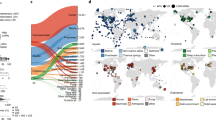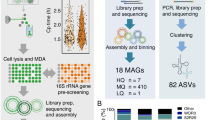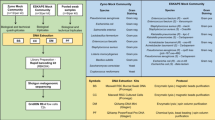Abstract
Single-cell genomics is a powerful tool for exploring the genetic makeup of environmental microorganisms, the vast majority of which are difficult, if not impossible, to cultivate with current approaches. Here we present a comprehensive protocol for obtaining genomes from uncultivated environmental microbes via high-throughput single-cell isolation by FACS. The protocol encompasses the preservation and pretreatment of differing environmental samples, followed by the physical separation, lysis, whole-genome amplification and 16S rRNA–based identification of individual bacterial and archaeal cells. The described procedure can be performed with standard molecular biology equipment and a FACS machine. It takes <12 h of bench time over a 4-d time period, and it generates up to 1 μg of genomic DNA from an individual microbial cell, which is suitable for downstream applications such as PCR amplification and shotgun sequencing. The completeness of the recovered genomes varies, with an average of ∼50%.
This is a preview of subscription content, access via your institution
Access options
Subscribe to this journal
Receive 12 print issues and online access
$259.00 per year
only $21.58 per issue
Buy this article
- Purchase on SpringerLink
- Instant access to full article PDF
Prices may be subject to local taxes which are calculated during checkout



Similar content being viewed by others
References
Rinke, C. et al. Insights into the phylogeny and coding potential of microbial dark matter. Nature 499, 431–437 (2013).
Amann, R.I., Ludwig, W. & Schleifer, K.H. Phylogenetic identification and in situ detection of individual microbial cells without cultivation. Microbiol. Rev. 59, 143–169 (1995).
Albertsen, M. et al. Genome sequences of rare, uncultured bacteria obtained by differential coverage binning of multiple metagenomes. Nat. Biotechnol. 31, 533–538 (2013).
Wrighton, K.C. et al. Fermentation, hydrogen, and sulfur metabolism in multiple uncultivated bacterial phyla. Science 337, 1661–1665 (2012).
Blainey, P.C. The future is now: single-cell genomics of bacteria and archaea. FEMS Microbiol. Rev. 37, 407–427 (2013).
Stepanauskas, R. Single cell genomics: an individual look at microbes. Curr. Opin. Microbiol. 15, 613–620 (2012).
Hess, M. et al. Metagenomic discovery of biomass-degrading genes and genomes from cow rumen. Science 331, 463–467 (2011).
Blainey, P.C., Mosier, A.C., Potanina, A., Francis, C.A. & Quake, S.R. Genome of a low-salinity ammonia-oxidizing archaeon determined by single-cell and metagenomic analysis. PLoS ONE 6, e16626 (2011).
Campbell, J.H. et al. UGA is an additional glycine codon in uncultured SR1 bacteria from the human microbiota. Proc. Natl. Acad. Sci. USA 110, 5540–5545 (2013).
Dodsworth, J.A. et al. Single-cell and metagenomic analyses indicate a fermentative and saccharolytic lifestyle for members of the OP9 lineage. Nat. Commun. 4, 1854 (2013).
Swan, B.K. et al. Prevalent genome streamlining and latitudinal divergence of planktonic bacteria in the surface ocean. Proc. Natl. Acad. Sci. USA 110, 11463–11468 (2013).
Woyke, T. et al. Assembling the marine metagenome, one cell at a time. PLoS ONE 4, e5299 (2009).
Yoon, H.S. et al. Single-cell genomics reveals organismal interactions in uncultivated marine protists. Science 332, 714–717 (2011).
McConnell, M.J. et al. Mosaic copy number variation in human neurons. Science 342, 632–637 (2013).
Zhang, K. et al. Sequencing genomes from single cells by polymerase cloning. Nat. Biotechnol. 24, 680–686 (2006).
Woyke, T. et al. One bacterial cell, one complete genome. PLoS ONE 5, e10314 (2010).
Landry, Z.C., Giovanonni, S.J., Quake, S.R. & Blainey, P.C. Optofluidic cell selection from complex microbial communities for single-genome analysis. Methods Enzymol. 531, 61–90 (2013).
Frumkin, D. et al. Amplification of multiple genomic loci from single cells isolated by laser micro-dissection of tissues. BMC Biotechnol. 8, 17 (2008).
Thompson, A., Bench, S., Carter, B. & Zehr, J. Coupling FACS and genomic methods for the characterization of uncultivated symbionts. Methods Enzymol. 531, 45–60 (2013).
Swan, B.K. et al. Potential for chemolithoautotrophy among ubiquitous bacteria lineages in the dark ocean. Science 333, 1296–1300 (2011).
Raghunathan, A. et al. Genomic DNA amplification from a single bacterium. Appl. Environ. Microbiol. 71, 3342–3347 (2005).
Dean, F.B. et al. Comprehensive human genome amplification using multiple displacement amplification. Proc. Natl. Acad. Sci. USA 99, 5261–5266 (2002).
Woyke, T. et al. Decontamination of MDA reagents for single cell whole genome amplification. PLoS ONE 6, e26161 (2011).
Rodrigue, S. et al. Whole genome amplification and de novo assembly of single bacterial cells. PLoS ONE 4, e6864 (2009).
Lasken, R.S. & Stockwell, T.B. Mechanism of chimera formation during the multiple displacement amplification reaction. BMC Biotechnol. 7, 19 (2007).
Stepanauskas, R. & Sieracki, M.E. Matching phylogeny and metabolism in the uncultured marine bacteria, one cell at a time. Proc. Natl. Acad. Sci. USA 104, 9052–9057 (2007).
Blainey, P.C. & Quake, S.R. Digital MDA for enumeration of total nucleic acid contamination. Nucleic Acids Res. 39, e19 (2011).
Miyauchi, R., Oki, K., Aoi, Y. & Tsuneda, S. Diversity of nitrite reductase genes in 'Candidatus Accumulibacter phosphatis'-dominated cultures enriched by flow-cytometric sorting. Appl. Environ. Microbiol. 73, 5331–5337 (2007).
Stackebrandt, E. & Ebers, J. Taxonomic parameters revisited: tarnished gold standard. Microbiology Today 33, 152–155 (2006).
Yarza, P. et al. Update of the All-Species Living Tree Project based on 16S and 23S rRNA sequence analyses. Syst. Appl. Microbiol. 33, 291–299 (2010).
McDonald, D. et al. An improved Greengenes taxonomy with explicit ranks for ecological and evolutionary analyses of bacteria and archaea. ISME J. 6, 610–618 (2012).
Chang, H.W. et al. Development of microbial genome-probing microarrays using digital multiple displacement amplification of uncultivated microbial single cells. Environ. Sci. Technol. 42, 6058–6064 (2008).
Frank, J.A. et al. Critical evaluation of two primers commonly used for amplification of bacterial 16S rRNA genes. Appl. Environ. Microbiol. 74, 2461–2470 (2008).
Mao, D.P., Zhou, Q., Chen, C.Y. & Quan, Z.X. Coverage evaluation of universal bacterial primers using the metagenomic datasets. BMC Microbiol. 12, 66 (2012).
Lane, D.J. in Nucleic Acid Techniques in Bacterial Systematics (eds. Stackebrandt, E. & Goodfellow, M.) 115–175 (John Wiley and Sons, 1991).
Caporaso, J.G. et al. Global patterns of 16S rRNA diversity at a depth of millions of sequences per sample. Proc. Natl. Acad. Sci. USA 108 (suppl. 1), 4516–4522 (2011).
An, D. et al. Metagenomics of hydrocarbon resource environments indicates aerobic taxa and genes to be unexpectedly common. Environ. Sci. Technol. 47, 10708–10717 (2013).
Cole, J.K. et al. Sediment microbial communities in Great Boiling Spring are controlled by temperature and distinct from water communities. ISME J. 7, 718–729 (2013).
Lane, D.J. et al. Rapid determination of 16S ribosomal RNA sequences for phylogenetic analyses. Proc. Natl. Acad. Sci. USA 82, 6955–6959 (1985).
Pace, N.R.S., Stahl, D.A., Lane, D.J. & Olsen, C.J. The use of rRNA sequences to characterize natural microbial populations. Adv. Microb. Ecol. 9, 1–55 (1986).
Page, K.A., Connon, S.A. & Giovannoni, S.J. Representative freshwater bacterioplankton isolated from Crater Lake, Oregon. Appl. Environ. Microbiol. 70, 6542–6550 (2004).
Casamayor, E.O., Schafer, H., Baneras, L., Pedros-Alio, C. & Muyzer, G. Identification of and spatio-temporal differences between microbial assemblages from two neighboring sulfurous lakes: comparison by microscopy and denaturing gradient gel electrophoresis. Appl. Environ. Microbiol. 66, 499–508 (2000).
Raskin, L., Stromley, J.M., Rittmann, B.E. & Stahl, D.A. Group-specific 16S rRNA hybridization probes to describe natural communities of methanogens. Appl. Environ. Microbiol. 60, 1232–1240 (1994).
Stahl, D.A.A. & Amann, R. in Nucleic Acid Techniques in Bacterial Systematics (eds. Stackebrandt, E. & Goodfellow, M.) 205–248 (John Wiley and Sons, 1991).
Zhu, F., Massana, R., Not, F., Marie, D. & Vaulot, D. Mapping of picoeucaryotes in marine ecosystems with quantitative PCR of the 18S rRNA gene. FEMS Microbiol. Ecol. 52, 79–92 (2005).
Medlin, L., Elwood, H.J., Stickel, S. & Sogin, M.L. The characterization of enzymatically amplified eukaryotic 16S-like rRNA-coding regions. Gene 71, 491–499 (1988).
Acknowledgements
The work conducted by the US DOE Joint Genome Institute is supported by the Office of Science of the US Department of Energy under contract no. DE-AC02-05CH11231. Work conducted by Bigelow Laboratory for Ocean Sciences is supported by National Science Foundation grants OCE-1232982, OCE-821374, EF-0633142, EF-826924 and MCB-738232.
Author information
Authors and Affiliations
Contributions
C.R., T.W., R.M. and R.S. conceived the strategies. C.R., J.L., N.N., D.G., B.T., N.P. and E.D. performed the experiments and analyzed the data. C.R. wrote the paper with significant input from T.W., R.M. and R.S.
Corresponding author
Ethics declarations
Competing interests
The authors declare no competing financial interests.
Rights and permissions
About this article
Cite this article
Rinke, C., Lee, J., Nath, N. et al. Obtaining genomes from uncultivated environmental microorganisms using FACS–based single-cell genomics. Nat Protoc 9, 1038–1048 (2014). https://doi.org/10.1038/nprot.2014.067
Published:
Issue date:
DOI: https://doi.org/10.1038/nprot.2014.067
This article is cited by
-
A compendium of bacterial and archaeal single-cell amplified genomes from oxygen deficient marine waters
Scientific Data (2023)
-
Synthase-selected sorting approach identifies a beta-lactone synthase in a nudibranch symbiotic bacterium
Microbiome (2023)
-
Glaciers as microbial habitats: current knowledge and implication
Journal of Microbiology (2022)
-
Metapangenomics reveals depth-dependent shifts in metabolic potential for the ubiquitous marine bacterial SAR324 lineage
Microbiome (2021)
-
Optofluidic Raman-activated cell sorting for targeted genome retrieval or cultivation of microbial cells with specific functions
Nature Protocols (2021)



